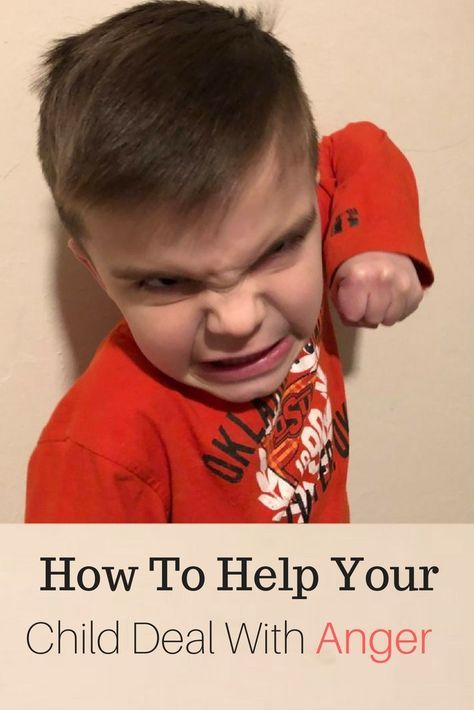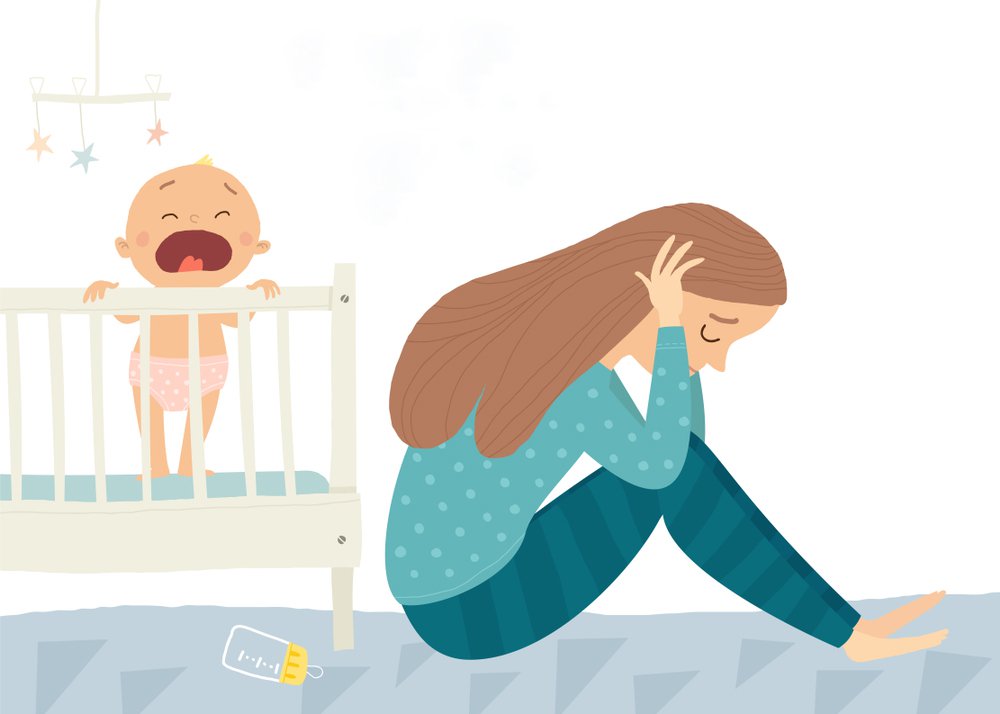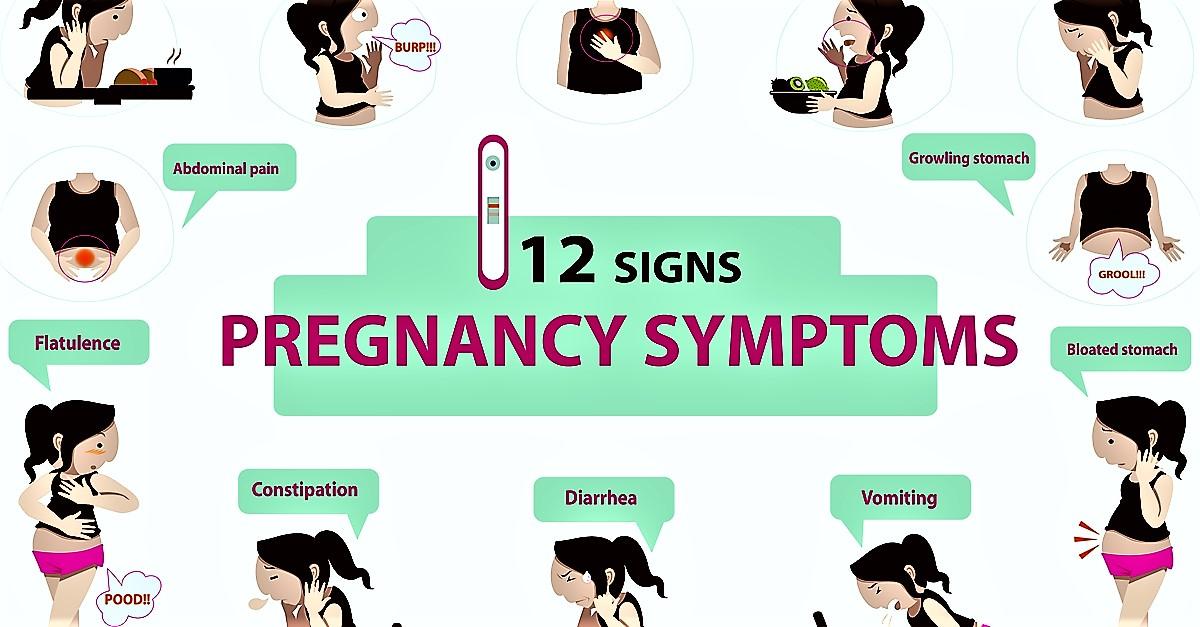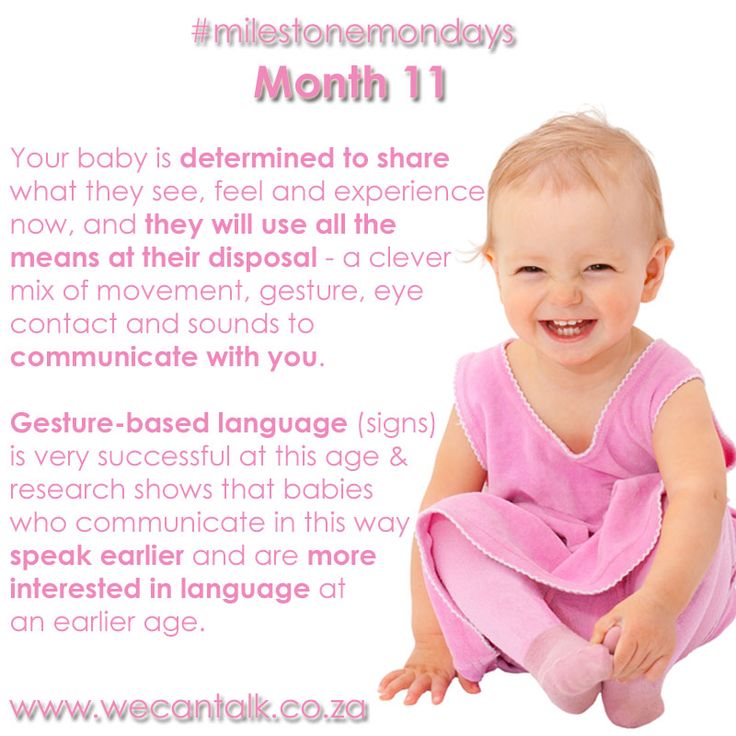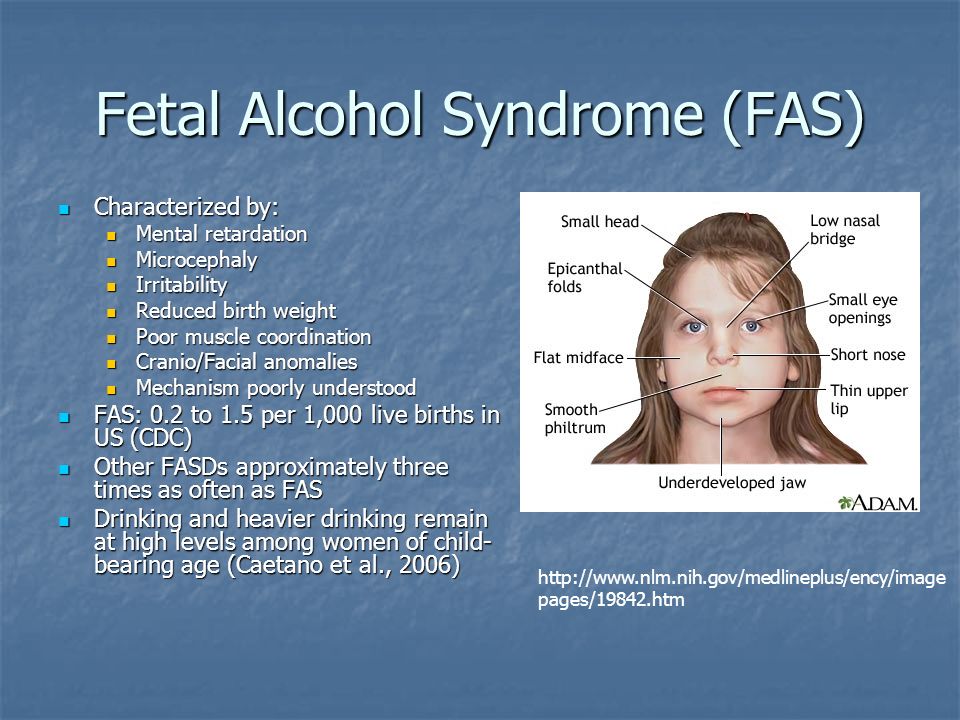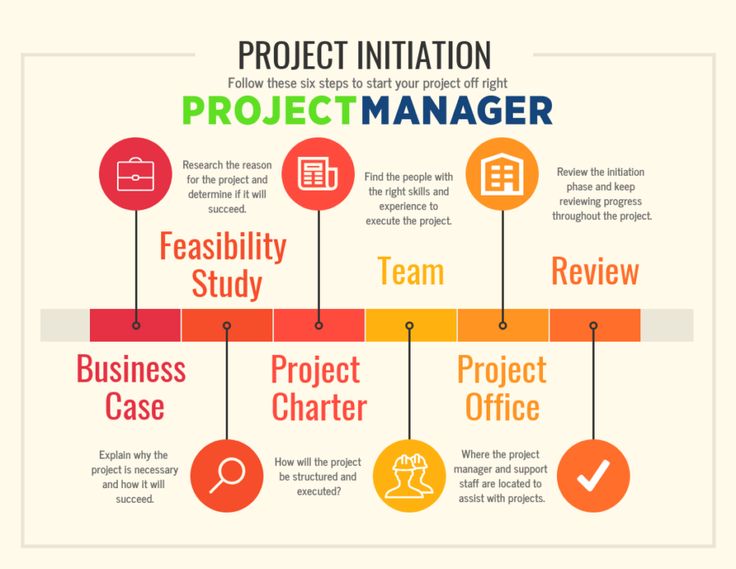How to help your child deal with bullies
Helping Kids Deal With Bullies (for Parents)
A bully can turn something like going to the bus stop or recess into a nightmare for kids. Bullying can leave deep emotional scars. And in extreme situations, it can involve violent threats, property damage, or someone getting seriously hurt.
If your child is being bullied, you want to act to help stop it, if possible. You can help your child cope with teasing, bullying, or mean gossip, and lessen its lasting impact. And even if bullying isn't an issue right in your house right now, it's important to discuss it so your kids will be prepared if it does happen.
When Is it Bullying?
Most kids get teased by a sibling or a friend at some point. And it's not usually harmful when done in a playful, friendly, and mutual way, and both kids find it funny. But when teasing becomes hurtful, unkind, and constant, it crosses the line into bullying and needs to stop.
Bullying is when peers intentionally use physical, verbal, or psychological ways to torment someone else, using a real or perceived power imbalance between the bully and the victim. Bullying can range from hitting, shoving, name-calling, threats, and mocking to extorting money and possessions. Some kids bully by shunning others and spreading rumors about them. Others use social media or electronic messaging to taunt others or hurt their feelings.
It's important to take bullying seriously and not just brush it off as something that kids have to "tough out." The effects can be serious and affect kids' sense of safety and self-worth. In severe cases, bullying has contributed to tragedies, such as suicides and school shootings.
Why Do Kids Bully?
Kids bully for a mix of reasons. Sometimes they pick on kids because they need a victim — someone who seems emotionally or physically weaker, or just acts or appears different in some way — to feel more important, popular, or in control. Although some bullies are bigger or stronger than their victims, that's not always the case.
Sometimes kids torment others because that's the way they've been treated.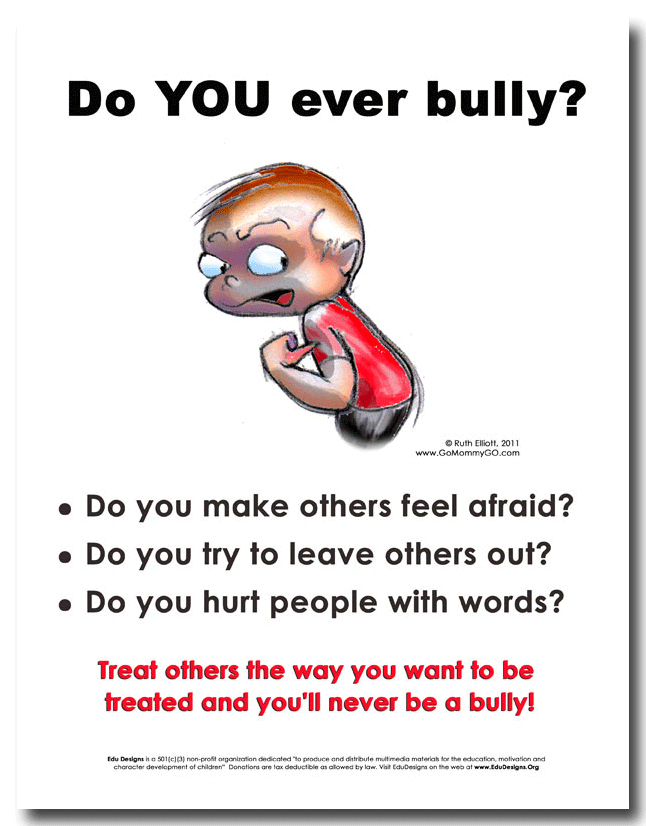 They may think their behavior is normal because they come from families or other settings where everyone regularly gets angry and shouts or calls each other names. Some popular TV shows even seem to promote meanness — people are "voted off," shunned, or ridiculed for their appearance or lack of talent.
They may think their behavior is normal because they come from families or other settings where everyone regularly gets angry and shouts or calls each other names. Some popular TV shows even seem to promote meanness — people are "voted off," shunned, or ridiculed for their appearance or lack of talent.
What Are the Signs of Bullying?
Unless your child tells you about bullying — or has visible bruises or injuries — it can be hard to know if it's happening.
But there are some warning signs. Parents might notice kids:
- acting differently or seeming anxious
- not eating, not sleeping well, or not doing the things they usually enjoy
- seem moodier or more easily upset than usual
- avoiding certain situations (like taking the bus to school)
If you suspect bullying but your child is reluctant to open up, find ways to bring up the issue. For instance, you might see a situation on a TV show and ask, "What do you think of this?" or "What do you think that person should have done?" This might lead to questions like: "Have you ever seen this happen?" or "Have you ever experienced this?" You might want to talk about any experiences you or another family member had at that age.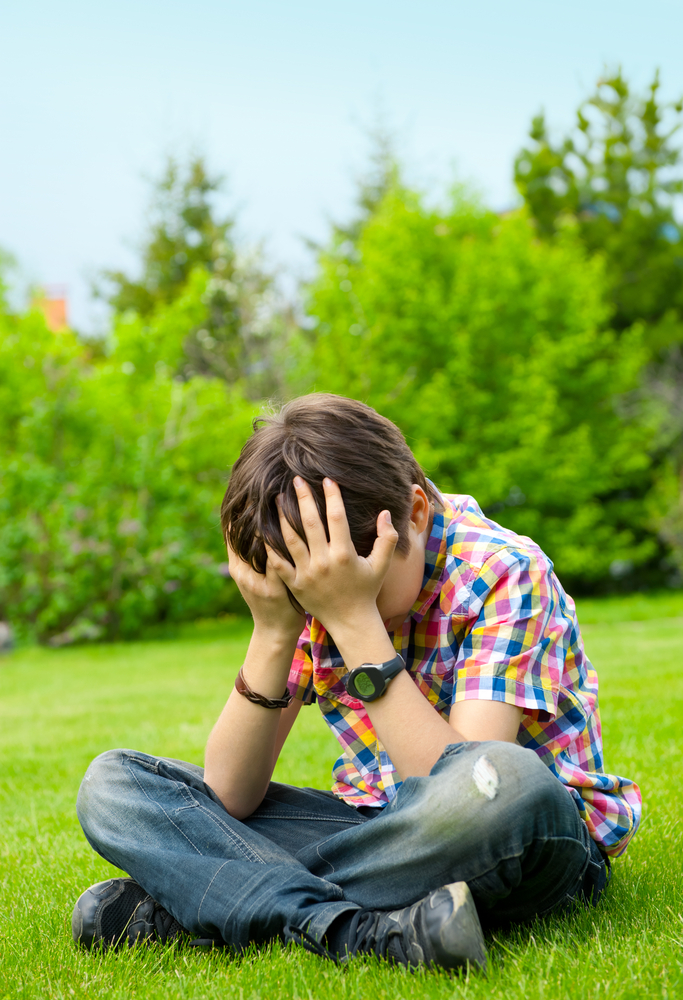
Let your kids know that if they're being bullied or harassed — or see it happening to someone else — it's important to talk to someone about it, whether it's you, another adult (a teacher, school counselor, or family friend), or a sibling.
What Can Families Do?
If your child tells you about being bullied, listen calmly and offer comfort and support. Kids are often reluctant to tell adults about bullying because they feel embarrassed and ashamed that it's happening, or worry that their parents will be disappointed, upset, angry, or reactive.
Sometimes kids feel like it's their own fault, that if they looked or acted differently it wouldn't be happening. Sometimes they're scared that if the bully finds out that they told, it will get worse. Others are worried that their parents won't believe them or do anything about it. Or kids worry that their parents will urge them to fight back when they're scared to.
Praise your child for doing the right thing by talking to you about it. Remind your child that they're not alone — a lot of people get bullied at some point. Explain that it's the bully who is behaving badly — not your child. Reassure them that you will figure out what to do about it together.
Remind your child that they're not alone — a lot of people get bullied at some point. Explain that it's the bully who is behaving badly — not your child. Reassure them that you will figure out what to do about it together.
In surveys, most kids and teens say that bullying happens at school. Let someone at school (the principal, school nurse, or a counselor or teacher) know about the situation. Often they can watch and take steps to prevent further problems.
"Bullying" can describe a wide range of situations, so there's no one-size-fits all approach. What works in one situation may not in another. Many things — such as the age of the kids involved, the severity of the situation, and the specific type of bullying behaviors — will help determine the best course of action.
Take it seriously if you hear that the bullying will get worse if the bully finds out that your child told or if threats of physical harm are involved. Sometimes it's useful to approach the bully's parents.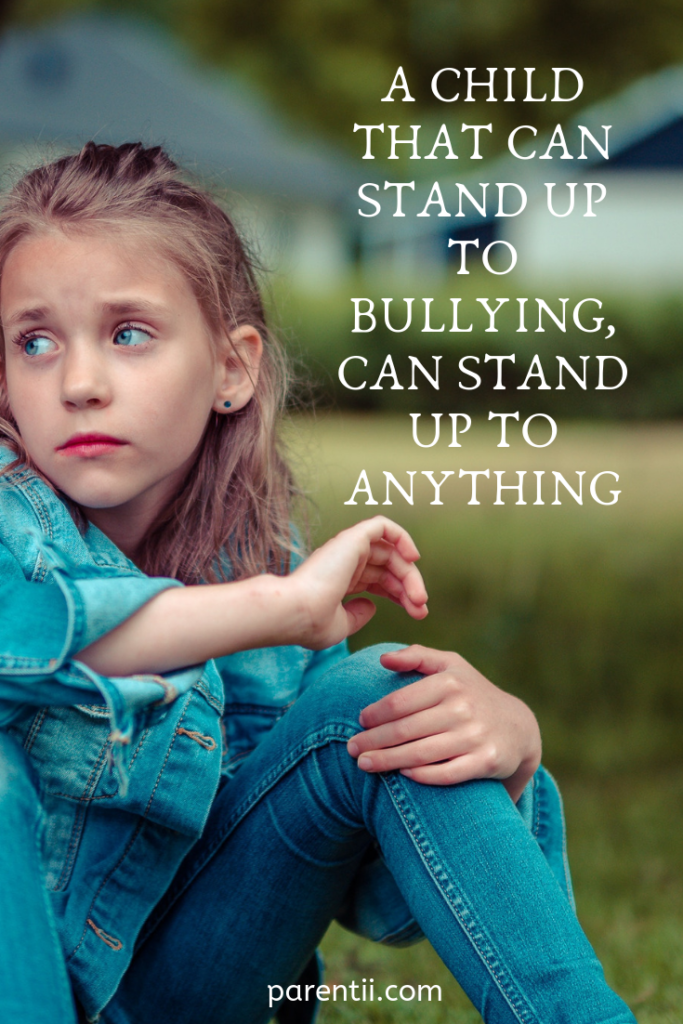 But in most cases, teachers or counselors are the best ones to contact first. If you've tried those methods and still want to speak to the bullying child's parents, it's best to do so where a school official, such as a counselor, can mediate.
But in most cases, teachers or counselors are the best ones to contact first. If you've tried those methods and still want to speak to the bullying child's parents, it's best to do so where a school official, such as a counselor, can mediate.
Most schools have bullying policies and anti-bullying programs. Also, many states have bullying laws and policies. Find out about the laws in your community. In some cases, if you have serious concerns about your child's safety, you may need to contact legal authorities.
Advice for Kids
Parents can help kids learn how to deal with bullying if it happens. For some parents or caregivers, it may be tempting to tell a kid to fight back. After all, you're angry that your child is suffering and maybe you were told to "stand up for yourself" when you were young. Or you may worry that your child will continue to be bullied, and think that fighting back is the only way to put a bully in their place.
But it's important to advise kids not to respond to bullying by fighting or bullying back.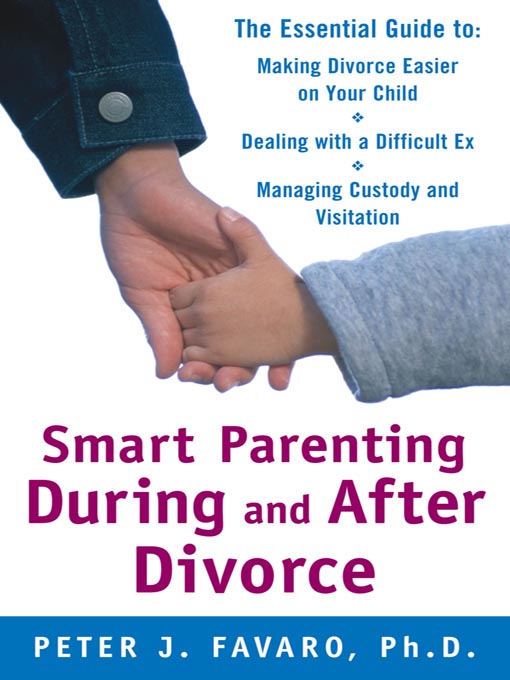 It can quickly escalate into violence, trouble, and someone getting injured. Instead, it's best to walk away from the situation, hang out with others, and tell an adult.
It can quickly escalate into violence, trouble, and someone getting injured. Instead, it's best to walk away from the situation, hang out with others, and tell an adult.
Here are some other ways kids can improve the situation and feel better:
- Tell an adult. Teachers, principals, parents, and lunchroom personnel at school can all help stop bullying.
- Avoid the bully and use the buddy system. Use a different bathroom if a bully is nearby and don't go to your locker if nobody else is around. Make sure you have someone with you so that you're not alone with the bully. Buddy up with a friend on the bus, in the hallways, or at recess — wherever the bully is. Offer to do the same for a friend.
- Hold the anger. It's natural to get upset by the bully, but that's what bullies thrive on. It makes them feel more powerful. Practice not reacting by crying or looking red or upset. It takes a lot of practice, but it's a useful skill for keeping off of a bully's radar.
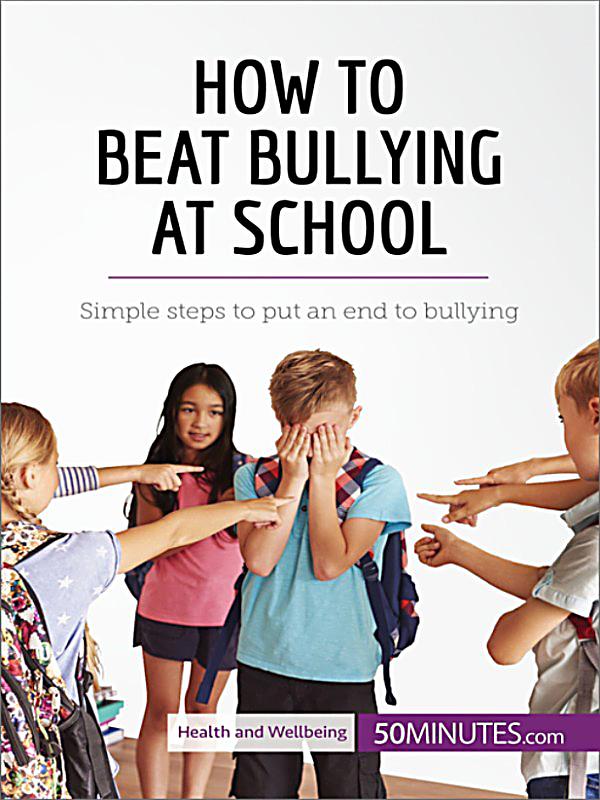 Sometimes kids find it useful to practice "cool down" strategies such as counting to 10, writing down their angry words, taking deep breaths, or walking away. Sometimes the best thing to do is to teach kids to keep their face calm until they are clear of any danger (smiling or laughing may provoke the bully).
Sometimes kids find it useful to practice "cool down" strategies such as counting to 10, writing down their angry words, taking deep breaths, or walking away. Sometimes the best thing to do is to teach kids to keep their face calm until they are clear of any danger (smiling or laughing may provoke the bully). - Act brave, walk away, and ignore the bully. Firmly and clearly tell the bully to stop, then walk away. Practice ways to ignore the hurtful remarks, like acting uninterested or texting someone on your cellphone. By ignoring the bully, you're showing that you don't care. Eventually, the bully will probably get bored with trying to bother you.
- Talk about it. Talk to someone you trust, such as a guidance counselor, teacher, sibling, or friend. They may offer some helpful suggestions. Even if they can't fix the situation, it may help you feel a little less alone.
Building Confidence
Dealing with bullying can hurt a child's confidence. To help rebuild it, encourage your kids to spend time with friends who have a positive influence. Participation in clubs, sports, or other enjoyable activities builds strength and friendships.
To help rebuild it, encourage your kids to spend time with friends who have a positive influence. Participation in clubs, sports, or other enjoyable activities builds strength and friendships.
Provide a listening ear about tough situations, but encourage your kids to also tell you about the good parts of their day, and listen attentively so that open communication becomes a habit for everyone. Make sure they know you believe in them and that you'll do what you can to address any bullying.
Reviewed by: Leah J. Orchinik, PhD
Date reviewed: March 2023
10 Ways to Help Your Child Deal With Bullies
1. Keep Your Cool
A bully is seeking to create fear and control. All experts agree that the most important thing to do is stay calm. This applies in all raised-anxiety situations. Think clearly and speak little. A bully is seeking reaction. Do not give it.
2. Walk Away
As stated above, a bully wants reaction more than anything else.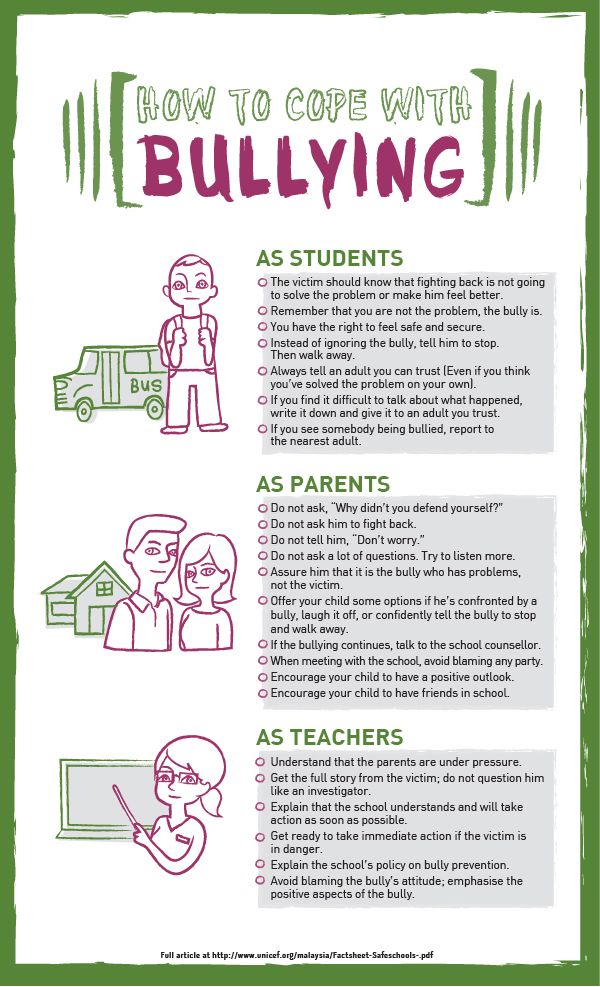 If possible, simply walk away. This steals away the thrill for the bully. Not being there to hear the threats or insults can likely stop the behavior towards you.
If possible, simply walk away. This steals away the thrill for the bully. Not being there to hear the threats or insults can likely stop the behavior towards you.
3. Strength in Numbers
Whenever possible, plan to walk with a friend or two when you are in areas you have been confronted. This might be recess, the lunch room, or in between classes. It is more intimidating for a bully to single you out when you are surrounded by supportive friends.
4. Face Your Fear
In some cases confronting the bully is your only option. Do not engage in either physical or verbal assaults. Simply stand up for yourself and tell the person to stop. You can also use a few well-timed comebacks. Such as, “Aren’t you tired of this yet?” Or, “I’ve got better things to do than listen to your nonsense.” Then walk away.
5. Know Thy Enemy
The most powerful weapon on earth is the human mind. Use it. Consider the person who is bullying you and what circumstances they may be under. In almost all cases, they are acting out in reaction to troubles in their own life. Maybe they are being abused. Maybe they are suffering from neglect. All sorts of tragic events could be the cause of the behavior. If an opening is given, offer your support and understanding. You may save a life.
In almost all cases, they are acting out in reaction to troubles in their own life. Maybe they are being abused. Maybe they are suffering from neglect. All sorts of tragic events could be the cause of the behavior. If an opening is given, offer your support and understanding. You may save a life.
6. Tell an Adult
It is important to learn how to handle your own social situations. It’s a part of growing up. However, if the bullying turns to threats of violence or emotional harm, it is time to tell your parents or teachers. Let an adult know exactly what has been happening. They will take the appropriate steps to end it.
7. Remove the Target
Sometimes children are ridiculed or harassed for specific reasons. Kids can be cruel. If there are changes that you can make to remove the target from your back, then do so. For example, if you are a Cowboys fan and you go to an Eagles game wearing a Tony Romo jersey, you are going to be harassed. Same thing applies in childhood. Make an effort to fit in with your age group.
Same thing applies in childhood. Make an effort to fit in with your age group.
8. Self-Confidence
Children with low self-esteem are likely targets of bullying. Take steps to improve this. Martial arts such as tae-kwon-do offer a fantastic way of helping a child gain confidence as well as maturity. Above all, make sure your own home is a secure and nurturing place.
9. Warning Signs
Statistics say that most bullying occurs between 6th and 8th grades and that males are more likely to be bullies as well as victims. Keep a close eye on your child during this time. Some possible signs there might be a problem are increased absenteeism, falling grades and depression. Talk to your child constantly about what is going on in his life. Make sure they know they are free to talk to you about anything and everything.
10. Take It Very Serious
If your child brings it up, chances are it’s a serious matter. So deal with it as such. School shootings have increased dramatically in recent years. Cyber bullying has resulted in several highly publicized teen suicides. Get all the information you can gather and if you need to, take it to the principal of your child’s school. Better safe than sorry.
School shootings have increased dramatically in recent years. Cyber bullying has resulted in several highly publicized teen suicides. Get all the information you can gather and if you need to, take it to the principal of your child’s school. Better safe than sorry.
5 Universal Ways to Deal with a Bully in the Classroom
Photos: Depositphotos / Illustrations: Julia Zamzhitskaya
Teachers often face situations that confuse them. For example, a student swears, threatens the teacher with violence, or asks provocative questions. Someone is looking for help from colleagues, someone - on the Internet, but both of them dream of universal techniques. Margarita Krylova, a teacher-consultant, arranged life-saving tips into memo cards* and shared some of them with the Teachers' Council.
1. Make it forbidden to make it mandatory
Let's say a child is a bully, gets distracted in class and draws the attention of other children. Require him to repeat the forbidden / undesirable action very often so that he gets tired of it. For example, every 10 minutes, have a minute of laughter in class when the troublemaker makes funny noises. The very demand will provoke protest. And if the child fulfills the requirement once, he will soon get bored with it. Mischief will turn into an obligation and will no longer be so desirable. The reception has one limitation: do not use in case of a threat to life and health.
Require him to repeat the forbidden / undesirable action very often so that he gets tired of it. For example, every 10 minutes, have a minute of laughter in class when the troublemaker makes funny noises. The very demand will provoke protest. And if the child fulfills the requirement once, he will soon get bored with it. Mischief will turn into an obligation and will no longer be so desirable. The reception has one limitation: do not use in case of a threat to life and health.
2. Stop on violation, resume on normal
Suppose children make noise during an explanation or shout out answers without raising their hands. As soon as there is such a mess, stop teaching the lesson. Wait until the noise subsides, the students calm down, and only then continue. To enhance the effect, some teachers generally begin to explain the topic from the very beginning.
3. Find a positive element in a bad deed
On purpose or not, children commit various tricks.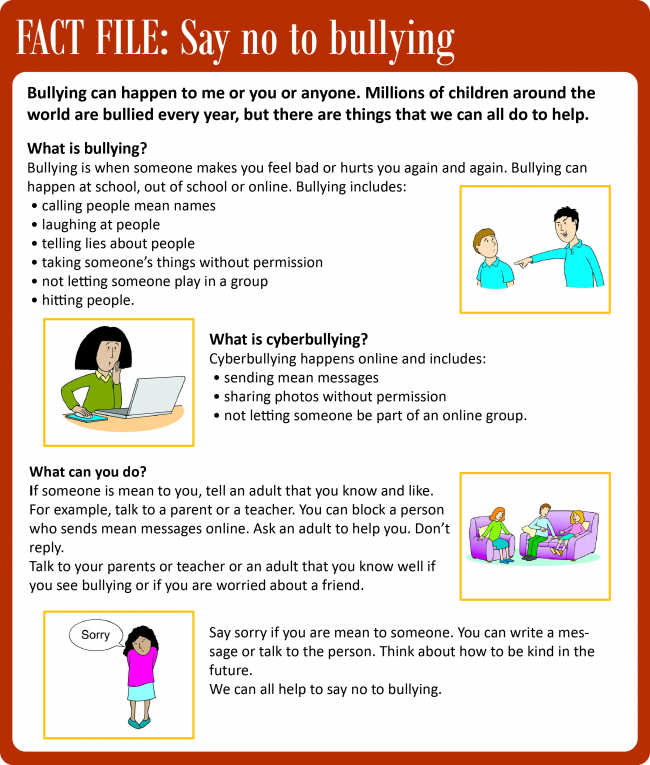 They turn on music in class, launch paper planes at the board, draw caricatures of teachers. For this, students most often receive a reprimand or lectures that they are not afraid of: they will nod and go on to misbehave. An alternative way out is to take advantage of mischief.
They turn on music in class, launch paper planes at the board, draw caricatures of teachers. For this, students most often receive a reprimand or lectures that they are not afraid of: they will nod and go on to misbehave. An alternative way out is to take advantage of mischief.
I painted the blackboard at recess - help decorate the class for the holiday.
“You draw so beautifully, your help will be irreplaceable for us. The school can win the competition thanks to your talents.”
The child is scolded all the time, but here they were praised. There is a new experience - to attract attention to yourself with something useful, meaningful and valuable to others.
“I turned on the music - thank you, I cheered everyone up. Come on, you will lead musical gymnastics.
Such an approach of the teacher will soften the temper of fidgets, and next time there will be less antics.
4. Agree with the insult and get back to business
A child in a fit of anger, despair can speak rudely to the teacher: “Fool!”, “What an evil teacher!”.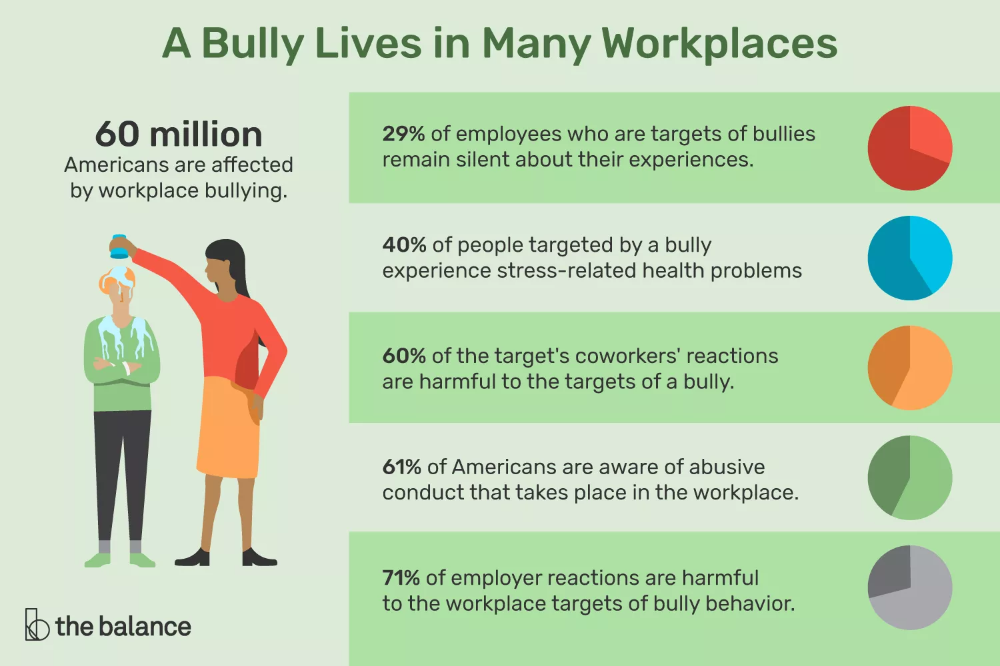 Not everyone will be able to let this past their ears - they will want retribution. But retaliation will only exacerbate the situation. One solution is to accept the accusation and get back to business.
Not everyone will be able to let this past their ears - they will want retribution. But retaliation will only exacerbate the situation. One solution is to accept the accusation and get back to business.
Admit guilt, even if it is not justified. An unexpected response will disarm the student. And then calmly continue the lesson or once again state your requirements for the rules of conduct. In action it will look like this:0006
Child: Fool!
Teacher: You are probably right, because I did not manage to teach you how to solve examples. I'll try another way. See...Or.
Child: What an evil teacher!
Teacher: Maybe you are right. Now open your textbook to page 217…
5. Transfer attention from the offender to the observers
Let's assume that the previous methods of stopping the bully did not work. The child, rather, turns his classmates on with them, they have fun, and he is glad that he can manage someone.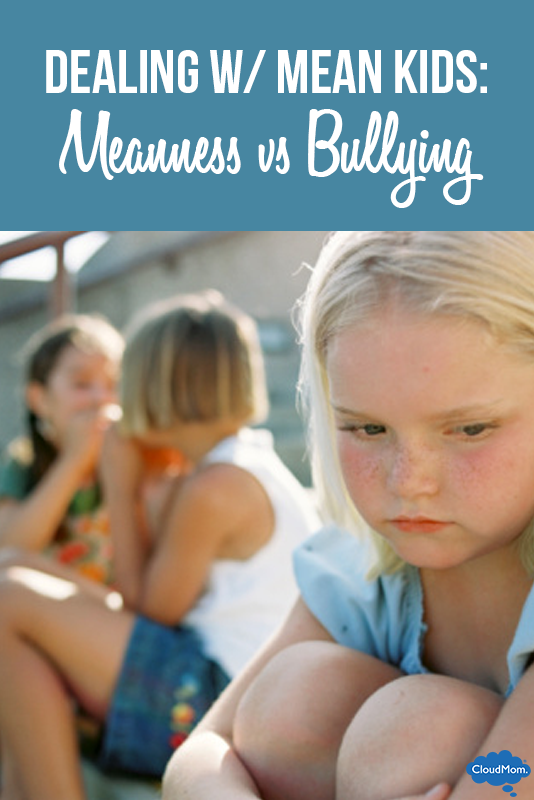 In this case, attention can be shifted from the intruder to the observers.
In this case, attention can be shifted from the intruder to the observers.
Involve other children in how to deal with the bully in the future: “What will we do with our…?” Let the rest of the students decide the fate of the violator, and he only watches. It looks like a collective court, but nonetheless. Such a measure is not very pleasant and will reduce the desire for antics.
*The kit is suitable for children up to 12 years of age
Related materials:
- "He just pisses me off!" How to deal with disobedient students?
- "We can do without tantrums": how to stop a student's emotional storm
- 6 tips to help keep discipline in the classroom
If you like the materials on the Pedagogical Council, subscribe to our Telegram channel to be the first to know about events.
Subscribe
What to do with a bully child in your school class.
 Where to apply? - May 25, 2021
Where to apply? - May 25, 2021 1
In the bully class. What to do?
There is no unified regulation on how to act in the event of an uncontrollable child in the classroom, says Dmitry Yurkov, director of the EGO Center for Psychological, Pedagogical, Medical and Social Assistance.
- There are different types of aggression that a child transmits. For example, there is aggression of a direct type, when a child "seizes" the territory or, defending himself, attacks first. Further, as a rule, a label is hung on him that he is crazy, inadequate and that something is wrong with him. And he begins to "work out" this scenario. The problem is that the pedagogical community reacts slowly and manages to give the child this label without having worked with him or his family,” the head of the center believes.
If the situation has already happened, the main thing for parents to do is to negotiate, the specialist assured.
— Everyone get together and offer to voluntarily invite the other party (the bully and his parents) to talk to them, to discuss.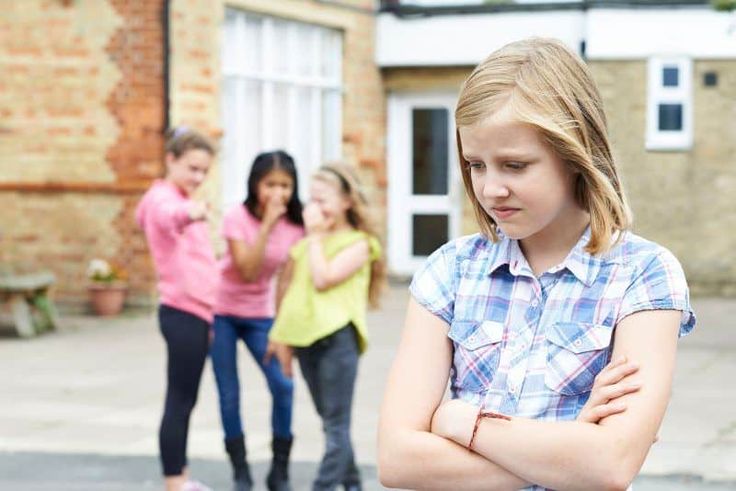 Understand what can change together. This will bring results only if everyone agrees voluntarily. It doesn't work on command. Everything will only get worse, - the teacher is sure.
Understand what can change together. This will bring results only if everyone agrees voluntarily. It doesn't work on command. Everything will only get worse, - the teacher is sure.
As a rule, if the conflict has already matured, the class teacher and the principal of the school are already aware, and it is in their interests, among other things, to resolve the situation peacefully, within the school. If you cannot solve the problem on your own, you can contact the Department of Education - they attract the necessary specialists to resolve the conflict.
Share
2
How to peacefully resolve the conflict between the student and the class?
The work of psychologists, social workers, and mediation services is now aimed at maintaining a favorable emotional background in each school. But both parents and students themselves should also be interested in solving the problem, experts are sure. Before looking for extreme and guilty people, it is important to remember what we teach our children.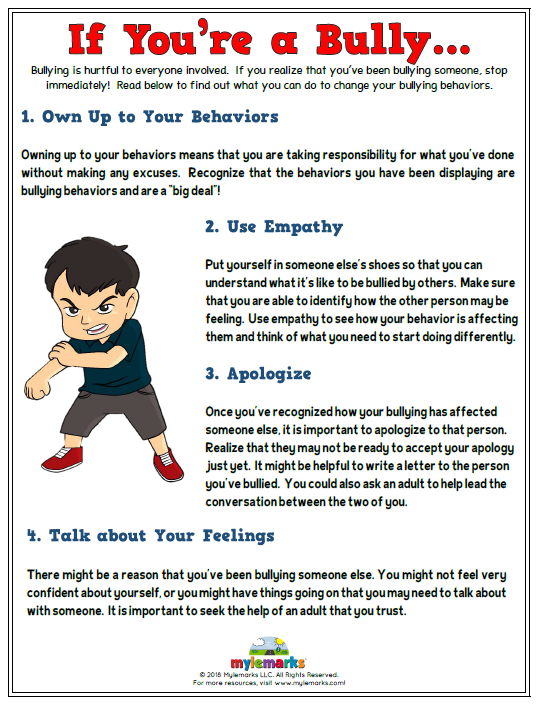
— In practice, there is the so-called technique of "Circles of negotiation". This is one of the most effective technologies for working with group conflict. It works when people need to agree, realizing that no one can be excluded. There is a "small circle" - when only children gather, there is a "big circle" when parents and children gather.
For example, I led a “circle” in which the situation was solved: a tenth grader was abandoned by his girlfriend, and he wrote “bitch” on her wall. The class was divided into two warring factions, the parents joined in. Everyone forgot about their studies, all day long they discussed only this conflict. We gathered everyone in the assembly hall and began to find a solution to this situation. They don't vote in the "circle of negotiations", they agree there, - explains the director of the EGO center Dmitry Yurkov, - if corrective help is needed for the family, this is also decided there. If you tell parents directly that your child has problems, he will prove that everything is in order with his child.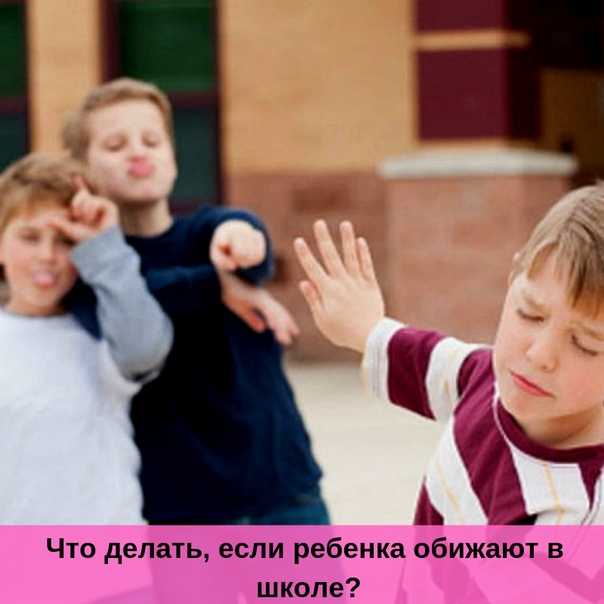 The conflict will get worse. It is important to understand that the child broadcasts the situation that he brought from home.
The conflict will get worse. It is important to understand that the child broadcasts the situation that he brought from home.
First you need to try to resolve the situation peacefully
Photo: Artyom Lents / NGS24.RU
Share
3
Whom to complain about a bully?
If your child is suffering at the hands or words of a classmate, the first thing to do is to contact the class teacher. He employs a school psychologist, a social worker or a mediation service.
“We try to ensure that every class teacher knows everything about their children,” Tatyana Rudneva, director of school No. 32, explains the technology of working with difficult teenagers. One school psychologist in a thousand children is not able to recognize everything. The problem is that a psychologist can work with a schoolchild only with the consent of the parents. And then the specialist finds out whether this problem is related to health, problems in the family or the behavior of the child.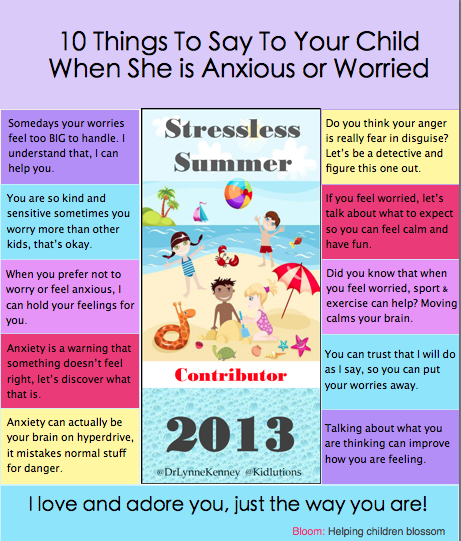
If this is a conflict, the school mediation service is connected. They're trying to come to an agreement. There should be a clear interaction "class teacher - parent - psychologist." Unfortunately, if the parents do not give consent, then nothing can be done. They say: “But he doesn’t behave like that at our house.” Yes, because you do not have a children's team at home! - the director of the Krasnoyarsk school Tatyana Rudneva is indignant.
The supervisor explained that parents do not always meet halfway. Many do not recognize the problem or are afraid that if they go to a specialist, the child will be “stigmatized”.
— Now, too, the fashion has gone: if something goes wrong at school, they transfer to family education. And the child will continue to live in society. Our task is to teach them to interact! Director is sure.
Share
4
The school does not resolve the conflict. What to do?
Education specialists shrug, there is no universal algorithm for solving problems with difficult teenagers at school.
If you want to hear an outside opinion and get independent advice, you can call the national Education Project hotline at 8 800 700-24-04. Here, any parent can get advice both at the regional and federal levels. The call is free.
If the consultation did not help, lawyer Vladimir Baryshev suggests resorting to more specific measures. First, in writing, apply with the appropriate application to the principal of the school. At the end of the application, indicate that in the absence of proper measures, you reserve the right to file a complaint with the department of education and law enforcement agencies. Secondly, contact the Department of Education and law enforcement agencies.
Thirdly, record the facts of harm to health, if any (at the emergency room), and find out who exactly mocks the child. Collect through the class teacher a parent committee with a call to the parents of offending children.
- Next - a fork. Here it will be determined whether an administrative offense (the Code of Administrative Offenses of the Russian Federation) or a crime (the Criminal Code of the Russian Federation) has been committed against the child. We must understand that the age of bringing to administrative responsibility for beatings and petty hooliganism begins at the age of 16. According to the Criminal Code of the Russian Federation, there are also a lot of compositions for causing harm to health, where the age of responsibility is also from 16 years old, with the exception of Article 111 of the Criminal Code of the Russian Federation “Beatings” - from 14 years old, the lawyer explained.
Thus, a juvenile delinquent hooligan must be identified by law enforcement agencies and a decision should be made to initiate proceedings on an administrative or criminal offense. Since we are talking about schoolchildren, the most likely scenario is a refusal to initiate a criminal case or an administrative case due to not reaching the age of responsibility, the expert predicts.
— However, the methods listed above are not exhaustive. A minor hooligan should be registered, his living conditions in the family should be checked.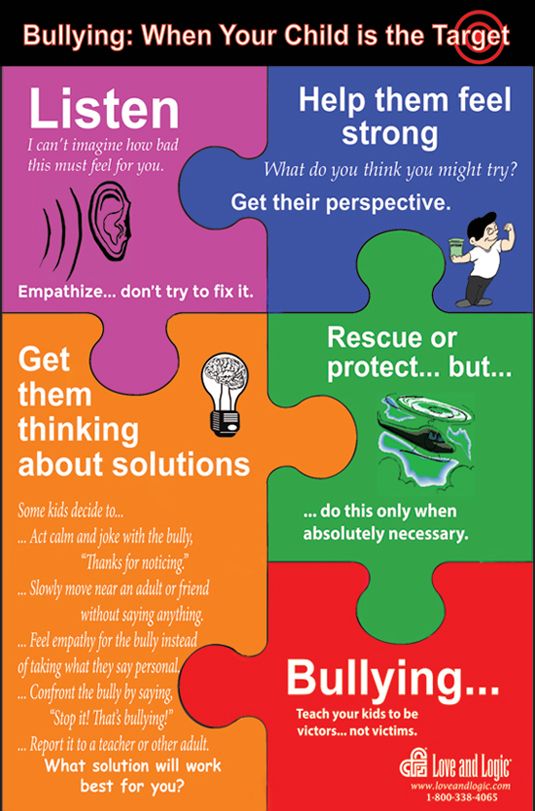 In case of harm to health, it is possible to recover compensation for non-pecuniary damage from the parents of the minor offender. In addition, if the harm to health was caused at the time of being at the lesson in the absence of due attention of the teacher, the court may impose liability in the form of compensation for moral damage on the educational institution, since, according to Article 41 of the Law on Education, the educational institution is obliged to create conditions guaranteeing the protection and strengthening the health of students, pupils, - assured the lawyer.
In case of harm to health, it is possible to recover compensation for non-pecuniary damage from the parents of the minor offender. In addition, if the harm to health was caused at the time of being at the lesson in the absence of due attention of the teacher, the court may impose liability in the form of compensation for moral damage on the educational institution, since, according to Article 41 of the Law on Education, the educational institution is obliged to create conditions guaranteeing the protection and strengthening the health of students, pupils, - assured the lawyer.
The lawyer advises to move from words to deeds if physical harm is caused
Photo: Artyom Lents / NGS24.RU
Share
5
How should children behave if there is a bully in the class?
Psychotherapist Anna Plotnikova explains:
— You need to understand very clearly that a bully is also a child.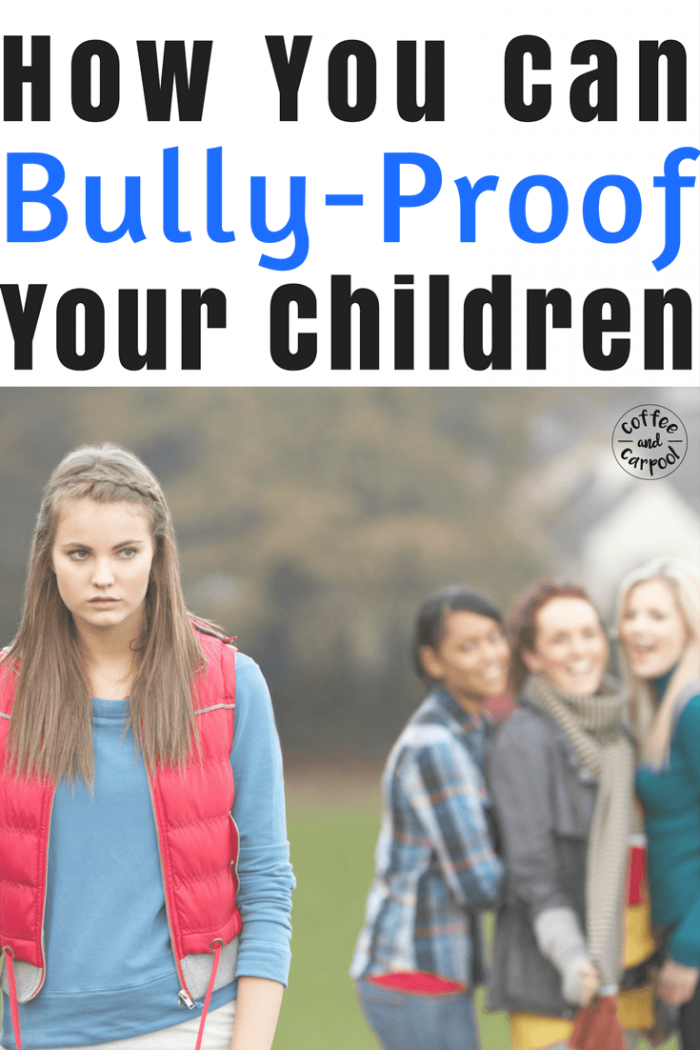 And it is important not to set boundaries - here you are a bully, and we do not teach you. Here it is important to teach children different behavior patterns. Very often, this circle narrows down to the models of parents that are most often projected by children. If we scream, then it is possible. If we kick something or someone, then it is possible. We throw papers on the street or call passersby names - that means it’s possible, - the specialist sorts it out.
And it is important not to set boundaries - here you are a bully, and we do not teach you. Here it is important to teach children different behavior patterns. Very often, this circle narrows down to the models of parents that are most often projected by children. If we scream, then it is possible. If we kick something or someone, then it is possible. We throw papers on the street or call passersby names - that means it’s possible, - the specialist sorts it out.
If your child is constantly bullied by another child in class, explain to the child “what if”. “What to do if your personal belongings were taken from you?” You can ask for your things back without being insulted. The second time you can warn - "you will take my things, I will take yours." The child must understand that each word must be consistent with his actions. The psychotherapist is sure that there would be fewer fights if we taught children to warn.
— It is necessary to say that warning adults about infringement of their rights is not a complaint. Our task is to give children an idea of the limits of the norm, Anna is sure. - It is important for parents to understand that we will not be able to organize a favorable environment around the child all our lives and select people who will surround him. But we can teach our children to interact with such people, not to run and hide, but to know how to stand up for themselves.
Our task is to give children an idea of the limits of the norm, Anna is sure. - It is important for parents to understand that we will not be able to organize a favorable environment around the child all our lives and select people who will surround him. But we can teach our children to interact with such people, not to run and hide, but to know how to stand up for themselves.
But not only children, but also adults must respond correctly to what is happening. With the change of generation, the mentality of teachers should also change, the director of school No. 32 is sure:
— Teachers are people too. Times change, generations change. Adolescence from the age of 14 has already passed to 11 - they already have a difficult period in the fifth grade. And the teachers are still on the knurled - 15, 20 years working at the school. And a child needs to be loved.
Share
6
Should I be transferred to another class?
Experts agree that these same problems will not end with the exclusion of a problem child from the class.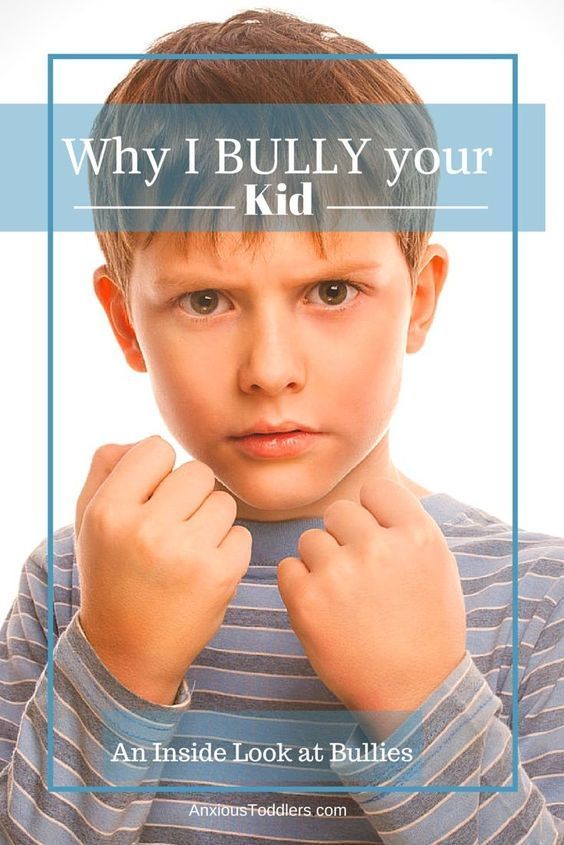
- Another child may come to this place. Or criminal situations are known when a child is expelled and then he takes revenge. Removing an aggressive child from the classroom does not end the conflict. Moreover, this way we will not teach children to resolve issues, to negotiate, to negotiate. If we don’t learn how to do this now at school, but only increase evil through exclusion and suppression, it will only grow, - based on his experience, says Dmitry Yurkov, director of the Center for Psychological and Pedagogical Assistance.
Tatyana Rudneva, director of school No. 32, agrees with the expert's opinion. The task of the school is to resolve the conflict and teach children to get out of it, and not to hide their heads in the sand.
— You can't run away from a problem. The mediation service is now well developed - it acts as a third party in resolving conflicts. Many serious consequences were thus avoided. It happens that the conflict is trifling, and the children are registered with the PDN.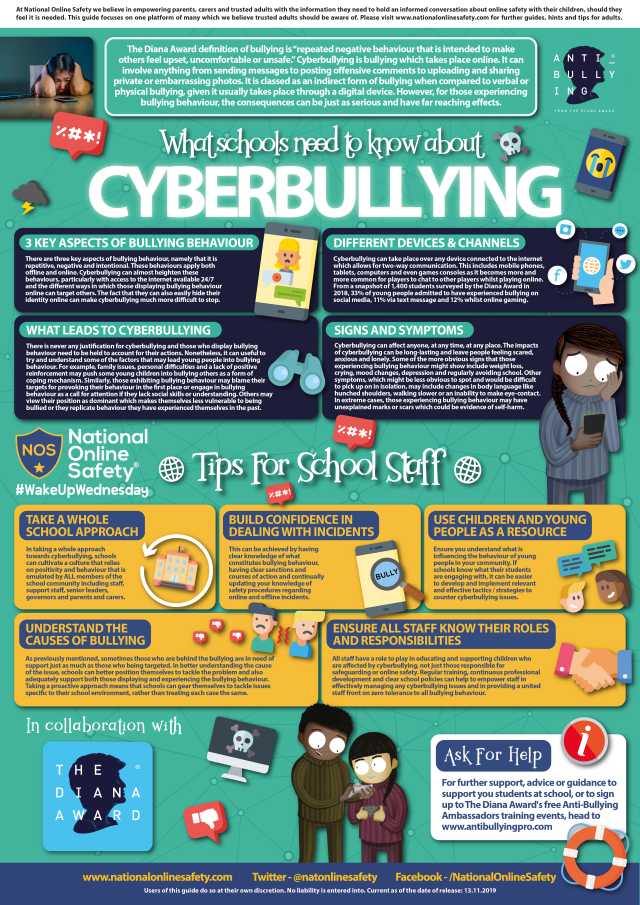 This shouldn’t be happening,” the director said.
This shouldn’t be happening,” the director said.
Removing a child from class is not an option
Photo: Artyom Lenz / NGS24.RU
Share
7
What if the bully is my child?
- Constantly telling your child that you are behaving badly is not an option. Most likely, this will cause resistance, and he will start to mess up even more. The most optimal thing in such a situation is to figure it out and answer the question, what exactly does the child want to show and prove by such behavior? And offer him to behave differently in a particular situation. And give a clear "what if" guide. And then the child will begin to change. The sooner this starts to happen, the more closely he will pay attention to the recommendations of adults. Because in this case, adults do not try to remake him, they offer him options that he can use, - psychotherapist Anna Plotnikova is convinced.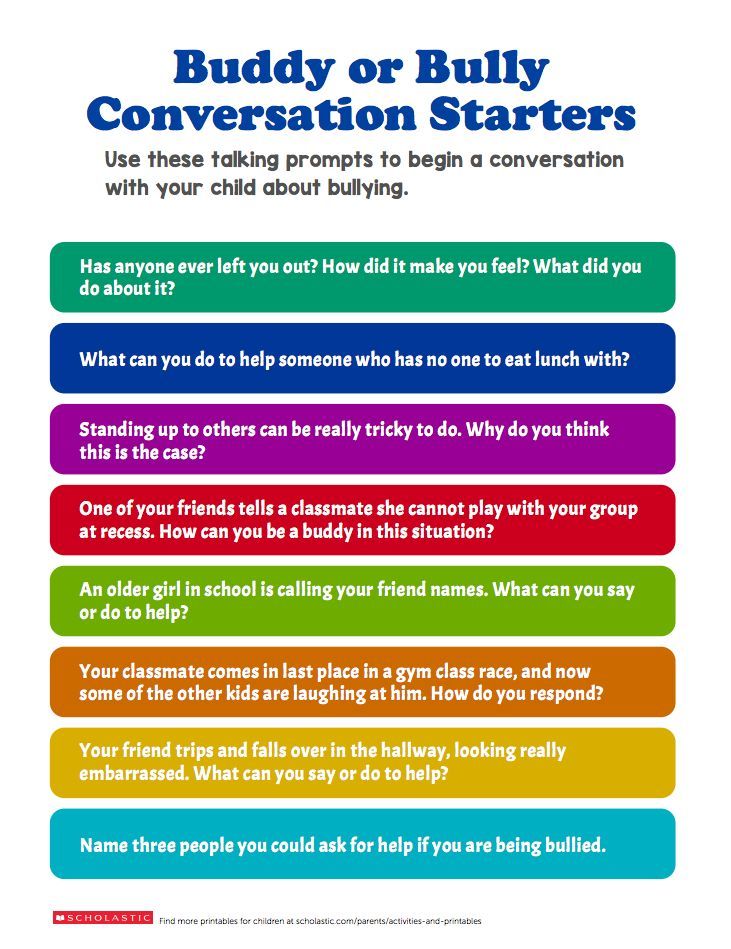
Man cannot be changed, he can be taught. You can show him. He can be given the opportunity to choose and explain that he is responsible for this choice.
- I had a case when they asked me for help. The child behaved very incorrectly in the classroom, they fought with him for a long time, he talked obscenely with teachers. Then I came and sat in class. It turned out that the school has a rule - leave the phones with the administrator during the lesson and pick them up only at recess. The student did not want to follow this rule. I asked him to give me the phone and go to the lesson. He told me: “You will not return him,” to which I replied: “I keep my word.”
I gave the phone to the administrator, he went to the lesson, and when he returned, I returned the phone and thanked him for fulfilling the request. Tears flowed from him, - the psychotherapist recalls, - no one has ever talked to a child in this way. And you know, this is a vivid example of the fact that when we change our pattern of behavior, the behavior of people around us also changes.